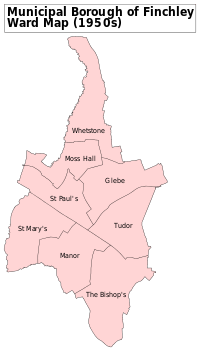History of Finchley
The History of Finchley charts its transformation from the rural parish of Finchley on the edge of the Forest of Middlesex, to its present situation as a mainly residential suburb of Greater London.
Origins
There is no evidence of Roman settlement in Finchley. Its few early medieval inhabitants maintained extensive woodlands that were cultivated to provide fuel and pigs for London. During the 12th and 13th centuries proper farming began, and by the 16th century the woods on the eastern side of the parish were cleared to form Finchley Common. By the 1270s there was a church and settlement at Church End.
Finchley, as an ancient parish, is around 2,899 acres (11.7 km2) (see plan). It was originally in the county of Middlesex, and included parts of what is now Hampstead Garden Suburb and Whetstone. Finchley is a Saxon place name, although its earliest recorded use is 13th century. The end of the name, "ley", suggests an opening in woodland, and the beginning, "Finch", refers either to the bird, or a person called Finch. It is not recorded in the Domesday book but by the 11th century the lands were already included in those of the Bishop of London, and probably formed part of the manor of Fulham.
A road north, later the Great North Road, was rerouted through the Bishop of London's estates at the end of the 13th century to pass through Finchley, and a small settlement developed in East Finchley during the following century. By the 16th century the Great North Road passed across Finchley Common, and by the 17th century there was a large hog market as well as a number of inns and other trades associated with transport in the period along its route.
From around 1547 Finchley had a parish vestry, which became a local board in 1878, an urban district in 1895, and finally a municipal borough (see coat of arms and description) between 1933 and 1965. It is now subsumed into the London Borough of Barnet.
By the 18th century Finchley was well known for the quality of its hay, which was the dominant agricultural activity until the second half of the 19th century. North Finchley only began to develop after the enclosure of the common during the 1820s.
19th century


In the late 1820s the Finchley Road was built from Marylebone to the Great North Road at Tallyho Corner, North Finchley. It became possible, through the use of an omnibus from 1827, for a small number of wealthy individuals to commute between London and Finchley, and the area acquired a number of villas and houses.
In 1867 the Great Northern Railway constructed a railway from Finsbury Park to Edgware, which passed through East Finchley and Church End. In 1872 a branch line was built between Church End and Barnet, and a further station was opened, later called Woodside Park. This in turn led to development of suburban houses, and a gradual increase in population. In 1905 a tramline from Archway to Whetstone via East Finchley was opened, joined in 1909 by another line running from New Southgate, through North Finchley and down Ballards Lane. These forms of cheap mass transportation enabled Finchley to become a proper suburb of London by 1914 (see plan of urban growth).
Small industries were established in the tram period, the first being small motor works on East End Road, at East Finchley (now a carpet store). There was only one large manufactory, Simms Motor Units, at Red Lion Hill, East Finchley, which in its heyday employed more than 2,000 (closed 1991). The Great Northern Railway line (by then part of the London and North Eastern Railway) became part of London Transport in 1939, with an underground link to Archway opened in 1940.
Population of Finchley from 1801–1961
- Population as a graph
- 1801 = 1,503
- 1811 = 1,292
- 1821 = 2,349
- 1831 = 3,210
- 1841 = 3,664
- 1851 = 4,120
- 1861 = 4,937
- 1871 = 7,146
- 1881 = 11,191
- 1891 = 16,677
- 1901 = 22,126
- 1911 = 39 419
- 1921 = 46,716
- 1931 = 58,964
- 1951 = 69,990
- 1961 = 69,370
References
External links
Kelly's directories
These contain lists of residents for Finchley and interesting descriptions of the area.
Further online resources for the history of Finchley
- Historical Post Cards from the collection of Clive Smith
- Prints and Paintings from Guildhall Collection
- Victoria County History for a more detailed history of Finchley
- Barnet Archives is the London Borough of Barnet local history library
- Finchley Society has a local history collection
- London Metropolitan Archives is the archive for the Greater London area